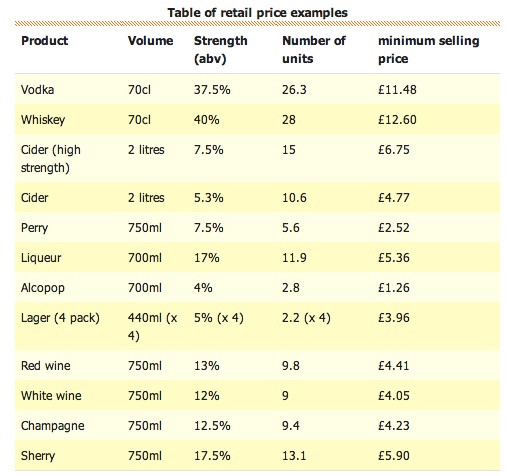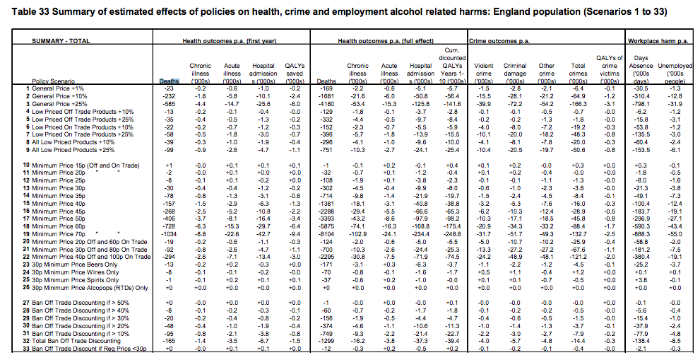Minimum alcohol pricing: what are the costs and benefits?
"In light of his u-turn on alcohol pricing, can the Prime Minister tell us if there was anything he *could* organise in a brewery" quipped Ed Miliband in Parliament today.
The u-turn in question is over the introduction of a minimum alcohol price of 45 pence per unit, after calls from some in the scientific community for action on alcohol-related diseases.
However, it was rumoured today that the Prime Minister and the Cabinet have scrapped the plan.
Below, the Home Office illustrated the minimum selling prices for various drinks, based on a 45 pence minimum alcohol price. Currently alcohol is selling as cheaply as 22 pence per unit.
Join 72,953 people who trust us to check the facts
Sign up to get weekly updates on politics, immigration, health and more.
Subscribe to weekly email newsletters from Full Fact for updates on politics, immigration, health and more. Our fact checks are free to read but not to produce, so you will also get occasional emails about fundraising and other ways you can help. You can unsubscribe at any time. For more information about how we use your data see our Privacy Policy.

So what would the impact of this policy be?
"Research has suggested a 45p minimum price could reduce drinking by 4.3%, potentially saving 2,000 lives within a decade." The Guardian, March 13, 2013
This claim is based on research carried out by Sheffield University and commissioned by the Department of Health in 2008. The change in consumption was calculated by taking into account both moderate and heavy drinkers.
The university found that low alcohol costs such as our current one (22 pence per unit) have little impact at reducing harmful outcomes.
The latest ONS statistical release on alcohol-related deaths revealed that there were 8,748 alcohol-related deaths in the UK, 42 fewer than in 2010 (8,790).
If that claim were true, curbing the amount of cheap booze would cut them by a marginal fraction: 200 per year. Most of the prevented deaths would occur in heavy drinkers.
As the table below shows, the university estimated that 2,288 lives would be saved over a decade once the policy is in "full effect".

"Some calculations put it [the revenue to the Treasury] at almost £12 billion by the end of 2015." Nick Robinson on the Today Programme, March 13, 2013
Nick Robinson is likely to be referring to calculations made by the Office for Budget Responsibility (OBR) and published in its Economic And Fiscal outlook report published in November 2011. As the quote below shows, the estimates seem to be correct.
"Alcohol duties are expected to increase from £9.9 billion in 2011-12 to around £12.5 billion by the end of the forecast period. This primarily reflects the pre-announced duty rises of 2 per cent above RPI inflation in each year to 2014-15 and the rise by RPI in 2015-16 and 2016-17. In each year of the forecast alcohol duties are around £0.2 billion to £0.3 billion higher than in the March EFO [Economic and Fiscal Outlook]. This is mainly explained by higher than expected receipts so far and a new forecast model, which predicts different growth rates in sales of beer, wine, spirits, and cider to those we had previously assumed. This offsets the effect of lower consumer spending on sales of alcohol over the forecast period."
"It's costing us around £21 billion a year just to deal with the crime and violence and the medical costs of it... It's the alcohol that's selling at 22p per unit that's killing people." Sarah Wollaston MP on the Today Programme, March 13, 2013
Back in 2003, the Cabinet Office estimated the total annual cost of alcohol misuse to the UK economy at around £20 billion. We factchecked a claim akin to this one last year, and charted the breakdown of costs by different categories:

More recently, in 2007, estimates produced by The National Social Marketing Centre and cited in a Parliamentary publication and an Alcohol Concern report estimated that alcohol abuse cost £55.1 billion, more than twice the Cabinet Office's figure.
However the costs to health services (£2.8 billion) and other public services (£2.1 billion) were a relatively small part of that, with the bulk of this sum falling within the £21 billion in cost to individuals and families, the £7.3 billion in cost to employers and the £21.9 billion in "human costs".
"The biggest growing group of alcoholics are middle class alcoholics." David Davis on the Today Programme, March 13, 2013
Some fear that, if implemented, the policy will affect average drinkers more than it will discourage heavy users. But who exactly is the average drinker?
According to the North West Public Health Observatory (NWPHO), more people drink to harmful levels in affluent areas than in poorer ones. However it's important to note that the report, published in August 2011, found that while the proportion of people who regularly exceed drinking guidelines are the most affluent, "consumption per head is highest among men in lower paid employment."
---
Flicks image courtesy of The Prime Minister's Office